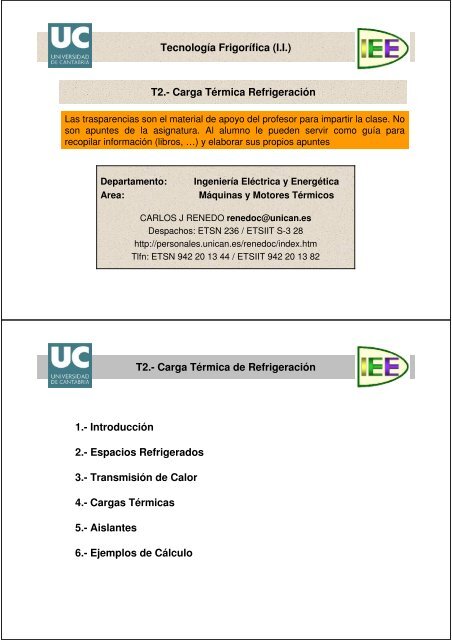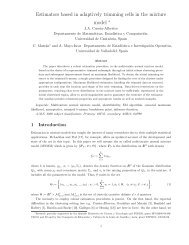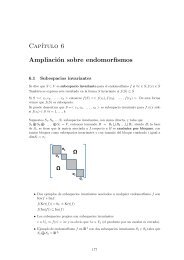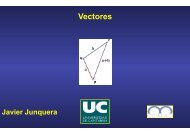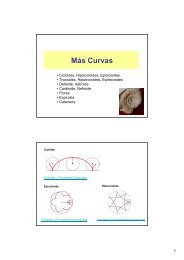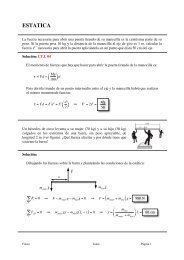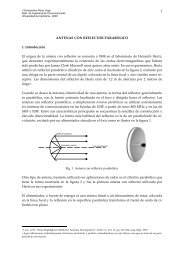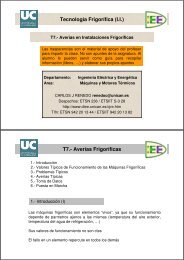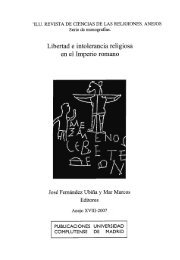You also want an ePaper? Increase the reach of your titles
YUMPU automatically turns print PDFs into web optimized ePapers that Google loves.
T2.- Carga Tecnología Térmica Frigorífica <strong>de</strong> <strong>Refrigeración</strong> (I.I.)<br />
T2.- Carga Térmica <strong>Refrigeración</strong><br />
Las trasparencias son el material <strong>de</strong> apoyo <strong>de</strong>l profesor para impartir la clase. No<br />
son apuntes <strong>de</strong> la asignatura. Al alumno le pue<strong>de</strong>n servir como guía para<br />
recopilar información (libros, …) y elaborar sus propios apuntes<br />
Departamento:<br />
Area:<br />
1.- Introducción<br />
Ingeniería Eléctrica y Energética<br />
Máquinas y Motores Térmicos<br />
CARLOS J RENEDO renedoc@unican.es<br />
Despachos: ETSN 236 / ETSIIT S-3 28<br />
http://personales.unican.es/renedoc/in<strong>de</strong>x.htm<br />
Tlfn: ETSN 942 20 13 44 / ETSIIT 942 20 13 82<br />
T2.- Carga Térmica <strong>de</strong> <strong>Refrigeración</strong><br />
2.- Espacios Refrigerados<br />
3.- Transmisión <strong>de</strong> Calor<br />
4.- <strong>Cargas</strong> <strong>Térmicas</strong><br />
5.- Aislantes<br />
6.- Ejemplos <strong>de</strong> Cálculo
1.- Introducción (I)<br />
CAMPOS DE<br />
UTILIZACIÓN<br />
DEL FRÍO<br />
1.- Introducción (II)<br />
T2.- Carga Térmica <strong>de</strong> <strong>Refrigeración</strong><br />
• Productos<br />
perece<strong>de</strong>ros<br />
• Climatización<br />
• Baja temperatura<br />
• Aplicaciones<br />
industriales<br />
• Pequeñas máquinas domésticas<br />
• <strong>Refrigeración</strong><br />
• Congelación<br />
• Almacenamiento<br />
• Transporte<br />
• Instalaciones Industriales (cerveza, leche…)<br />
• De “confort”<br />
• Climas industriales<br />
• Superconductividad<br />
• Criogenia<br />
• Metalurgia<br />
• Biomédicas<br />
• Liofilización (también en otros usos)<br />
• Usos clínicos<br />
• Industria Química<br />
• Construcción (Fraguado)<br />
• Fábricas hielo<br />
• Pistas patinaje<br />
T2.- Carga Térmica <strong>de</strong> <strong>Refrigeración</strong><br />
Métodos <strong>de</strong> cálculo <strong>de</strong> cargas térmicas:<br />
• <strong>Cargas</strong> instantáneas<br />
• Funciones <strong>de</strong> transferencia<br />
• Métodos numéricos<br />
En el caso <strong>de</strong> las cargas térmicas <strong>de</strong> refrigeración el proceso es bastante<br />
más sencillo.<br />
Para equipos <strong>de</strong> pequeñas dimensiones basta normalmente la utilización <strong>de</strong><br />
tablas. Sin embargo, para la utilización <strong>de</strong> tablas han <strong>de</strong> conocerse los<br />
fundamentos teóricos.
T2.- Carga Térmica <strong>de</strong> <strong>Refrigeración</strong><br />
2.- Espacios Refrigerados (I)<br />
Requisitos que <strong>de</strong>ben cumplir los espacios refrigerados:<br />
• Aislamiento frente a la transmisión <strong>de</strong> calor.<br />
• Barrera <strong>de</strong> vapor contra la humedad – Sellado <strong>de</strong> juntas<br />
• Puertas <strong>de</strong> acceso <strong>de</strong> dimensiones a<strong>de</strong>cuadas Pero herméticas.<br />
• Protección frente a focos <strong>de</strong> calor (pinturas, revestimientos…)<br />
T2.- Carga Térmica <strong>de</strong> <strong>Refrigeración</strong><br />
2.- Espacios Refrigerados (II)<br />
Aislamiento frente a la transmisión <strong>de</strong> calor<br />
Un buen aislante <strong>de</strong>be satisfacer ciertos requisitos:<br />
• Resistencia máxima al flujo <strong>de</strong> calor<br />
• Estabilidad: no se <strong>de</strong>be pudrir<br />
• No <strong>de</strong>be ser inflamable<br />
• No <strong>de</strong>be absorber humedad, ya que pue<strong>de</strong> per<strong>de</strong>r sus propieda<strong>de</strong>s<br />
• Debe ser a prueba <strong>de</strong> roedores e insectos<br />
• Debe ser manejable y fácil <strong>de</strong> instalar<br />
• Debe tener un precio razonable<br />
• De fácil disposición
T2.- Carga Térmica <strong>de</strong> <strong>Refrigeración</strong><br />
2.- Espacios Refrigerados (III)<br />
Barrera <strong>de</strong> vapor frente a la humedad<br />
La mayor parte <strong>de</strong> los aislantes térmicos pier<strong>de</strong>n sus características<br />
aislantes por la presencia <strong>de</strong> humedad en su interior<br />
El agua acumulada pue<strong>de</strong> apelmazar el aislante y hacer que éste pierda<br />
parte <strong>de</strong> sus propieda<strong>de</strong>s (<strong>de</strong>splaza el aire)<br />
Si el agua se llega a congelar, pue<strong>de</strong> <strong>de</strong>struir las pare<strong>de</strong>s <strong>de</strong>l espacio<br />
refrigerado al dilatarse<br />
Es habitual sellar la pared exterior, <strong>de</strong>jando juntas en la pared interior para<br />
evacuar la humedad, que se convertirá en escarcha en el evaporador<br />
T2.- Carga Térmica <strong>de</strong> <strong>Refrigeración</strong><br />
2.- Espacios Refrigerados (III)<br />
Barrera <strong>de</strong> vapor frente a la humedad<br />
La mayor parte <strong>de</strong> los aislantes térmicos pier<strong>de</strong>n sus características<br />
aislantes por la presencia <strong>de</strong> humedad en su interior<br />
El agua acumulada pue<strong>de</strong> apelmazar el aislante y hacer que éste pierda<br />
parte <strong>de</strong> sus propieda<strong>de</strong>s (<strong>de</strong>splaza el aire)<br />
Si el agua se llega a congelar, pue<strong>de</strong> <strong>de</strong>struir las pare<strong>de</strong>s <strong>de</strong>l espacio<br />
refrigerado al dilatarse<br />
La humedad con<strong>de</strong>nsa si la T superficial<br />
es inferior a la <strong>de</strong> rocío <strong>de</strong>l aire<br />
Es habitual sellar la pared exterior, <strong>de</strong>jando juntas en la pared interior para<br />
evacuar la humedad, que se convertirá en escarcha en el evaporador
T2.- Carga Térmica <strong>de</strong> <strong>Refrigeración</strong><br />
2.- Espacios Refrigerados (IV)<br />
Puertas <strong>de</strong> acceso<br />
Deben asegurar la continuidad <strong>de</strong>l aislante. Por ello, a veces su peso es<br />
excesivo y necesitan sólidos sistemas <strong>de</strong> anclaje<br />
Otros casos, como las vitrinas expositoras, no se <strong>de</strong>ben empañar<br />
El cristal es un aislante pobre, por lo que la solución pasa por varias capas<br />
con cámara <strong>de</strong> aire, nitrógeno, argón u otros gases nobles<br />
T2.- Carga Térmica <strong>de</strong> <strong>Refrigeración</strong><br />
2.- Espacios Refrigerados (IV)<br />
Puertas <strong>de</strong> acceso<br />
Deben asegurar la continuidad <strong>de</strong>l aislante. Por ello, a veces su peso es<br />
excesivo y necesitan sólidos sistemas <strong>de</strong> anclaje<br />
Otros casos, como las vitrinas expositoras, no se <strong>de</strong>ben empañar<br />
El cristal es un aislante pobre, por lo que la solución pasa por varias capas<br />
con cámara <strong>de</strong> aire, nitrógeno, argón u otros gases nobles
T2.- Carga Térmica <strong>de</strong> <strong>Refrigeración</strong><br />
2.- Espacios Refrigerados (V)<br />
Protección frente a focos <strong>de</strong> calor<br />
Por puro sentido común, no se <strong>de</strong>be situar maquinaria productora <strong>de</strong> calor<br />
cerca <strong>de</strong> los espacios refrigerados (cal<strong>de</strong>ras, etc.)<br />
Si es posible, evitar el emplazamiento con el exterior expuesto al sol<br />
Si no es posible, provocar sombras, pintar la superficie <strong>de</strong> color blanco o<br />
revestirla <strong>de</strong> aluminio<br />
T2.- Carga Térmica <strong>de</strong> <strong>Refrigeración</strong><br />
3.- Transmisión <strong>de</strong> Calor (I)<br />
Para la transmisión <strong>de</strong> calor es necesario diferencia <strong>de</strong> T, transmitiéndose<br />
el calor <strong>de</strong> los cuerpos <strong>de</strong> mayor T a los <strong>de</strong> menor<br />
La Termodinámica estudia los procesos <strong>de</strong> transferencia <strong>de</strong> energía en<br />
sistemas en equilibrio<br />
La Transmisión <strong>de</strong> Calor complementa los principios <strong>de</strong> la Termodinámica,<br />
<strong>de</strong> manera que puedan <strong>de</strong>terminarse aspectos tales como:<br />
– Velocidad <strong>de</strong> la transferencia <strong>de</strong> calor<br />
– Estados intermedios<br />
Los mecanismos <strong>de</strong> transmisión <strong>de</strong> calor:<br />
• Conducción, en el interior <strong>de</strong> los cuerpos<br />
• Convección, entre sólidos y fluidos<br />
• Radiación, a través <strong>de</strong> un fluido, o el vacío
T2.- Carga Térmica <strong>de</strong> <strong>Refrigeración</strong><br />
3.- Transmisión <strong>de</strong> Calor (II)<br />
CONDUCCION: en el interior <strong>de</strong> los sólidos<br />
Conductividad térmica, λ (W / m ºC), (tablas)<br />
es función <strong>de</strong> la temperatura <strong>de</strong>l material<br />
Material<br />
Aluminio<br />
Cartón<br />
Cemento<br />
Cobre<br />
λ (W / m ºC)<br />
204<br />
0,14-0,35<br />
1<br />
386<br />
Material<br />
Corcho<br />
Granito<br />
Hormigón (seco)<br />
Ladrillo<br />
Casos típicos <strong>de</strong> conducción térmica (I)<br />
1.- Para una pared <strong>de</strong> conductividad térmica λλλλ<br />
λ (W / m ºC)<br />
0,04<br />
3<br />
0,128<br />
0,3-5<br />
La resistencia <strong>de</strong> conducción <strong>de</strong> la pared R k = δδδδ / λλλλ A<br />
t t t<br />
pi<br />
t<br />
A<br />
⎜⎛<br />
pi<br />
−<br />
pe<br />
⎟⎞<br />
⎜⎛<br />
−<br />
pe<br />
⎟⎞<br />
P = λ t<br />
pi<br />
t<br />
⎝ ⎠ ⎝ ⎠<br />
⎜⎛<br />
−<br />
pe<br />
⎟⎞<br />
=<br />
=<br />
δ ⎝ ⎠ δ<br />
R<br />
k<br />
λ A<br />
Cobre<br />
200 K<br />
273 K<br />
400 K<br />
T2.- Carga Térmica <strong>de</strong> <strong>Refrigeración</strong><br />
3.- Transmisión <strong>de</strong> Calor (III)<br />
Casos típicos <strong>de</strong> conducción térmica (II)<br />
λ (W / m ºC)<br />
413<br />
401<br />
392<br />
Conductores (λ ↑)<br />
Aislantes térmicos (λ ↓)<br />
2.- Para una pared plana recubierta <strong>de</strong> un aislante <strong>de</strong> conductividad λλλλ´<br />
A ⎛ ⎞ A<br />
P = λ<br />
=<br />
⎛ ⎞<br />
⎜t<br />
− t ⎟ λ´<br />
⎜t<br />
− t ⎟ =<br />
δ ⎝ pi p´<br />
⎠ δ´<br />
⎝ p´<br />
pe ⎠<br />
⎛<br />
t t<br />
⎞ ⎛<br />
t ´ t<br />
⎞ ⎛<br />
t t<br />
⎞<br />
⎜ −<br />
pi p´<br />
⎟ ⎜ −<br />
p pe<br />
⎟ ⎜ −<br />
pi pe<br />
⎟<br />
=<br />
⎝ ⎠<br />
=<br />
⎝ ⎠<br />
=<br />
⎝ ⎠<br />
R R ´ δ δ´<br />
k k<br />
+<br />
λ A λ´<br />
A<br />
3.- Para dos pare<strong>de</strong>s en paralelo <strong>de</strong> áreas A 1 y A 2 <strong>de</strong> material diferente, <strong>de</strong><br />
igual espesor, δδδδ, cada una <strong>de</strong> ellas con conductividad térmica, λλλλ 1 , λλλλ 2<br />
Siendo R k la resistencia térmica equivalente <strong>de</strong> las dos pare<strong>de</strong>s<br />
t<br />
pi<br />
− t<br />
pe<br />
t<br />
pi<br />
− t<br />
pe<br />
t<br />
pi<br />
− t<br />
pe<br />
P = P1<br />
+ P2<br />
= + = ;<br />
R<br />
k1<br />
R<br />
k2<br />
R<br />
k<br />
1<br />
R<br />
k<br />
=<br />
1<br />
R<br />
k1<br />
+<br />
1<br />
R<br />
k2<br />
⎛ ⎞ ⎛ ⎞<br />
⎜t<br />
− t ⎟ ⎜t<br />
´ − t ⎟<br />
⎝ pi p´<br />
⎠<br />
=<br />
⎝ p pe ⎠<br />
=<br />
δ<br />
δ´<br />
λ A λ´<br />
A<br />
⎛<br />
t t<br />
⎞<br />
⎜ −<br />
pi pe<br />
⎟<br />
=<br />
⎝ ⎠<br />
R + R<br />
k k´<br />
;
t − t<br />
pi<br />
2 π λ L<br />
Ln (<br />
r<br />
e<br />
T2.- Carga Térmica <strong>de</strong> <strong>Refrigeración</strong><br />
Casos típicos <strong>de</strong> conducción térmica (III)<br />
4.- Para una tubería cilíndrica <strong>de</strong> conductividad térmica λλλλ<br />
La resistencia <strong>de</strong> conducción <strong>de</strong>l tubo<br />
P =<br />
3.- Transmisión <strong>de</strong> Calor (IV)<br />
pe<br />
/ r )<br />
i<br />
=<br />
t − t<br />
pi pe<br />
Ln ( r / r )<br />
e i<br />
2 π λ L<br />
5.- Tubería cilíndrica ro<strong>de</strong>ada <strong>de</strong> una vaina aislante <strong>de</strong> conductividad λλλλ´,<br />
t − t t − t t − t<br />
p´<br />
pe pi p´<br />
p´<br />
pe<br />
=<br />
= =<br />
Ln ( r / r )<br />
e i<br />
R R<br />
k k´<br />
2 π λ´<br />
L<br />
R<br />
kTubo<br />
t − t<br />
pi pe<br />
=<br />
R<br />
k<br />
t − t<br />
t − t<br />
pi p´<br />
p´<br />
pe<br />
P = 2 π λ L<br />
= 2 π λ´<br />
L<br />
=<br />
Ln ( r´<br />
/ r ) Ln ( r / r´<br />
)<br />
i<br />
e<br />
;<br />
Ln ( r / r )<br />
=<br />
e i<br />
2 π λ L<br />
t − t<br />
pi p´<br />
=<br />
Ln ( r / r )<br />
e i<br />
2 π λ L<br />
t −<br />
pi<br />
=<br />
R +<br />
k<br />
t<br />
pe<br />
R<br />
k´<br />
T2.- Carga Térmica <strong>de</strong> <strong>Refrigeración</strong><br />
3.- Transmisión <strong>de</strong> Calor (V)<br />
CONVECCION: entre sólidos y fluidos<br />
Coeficiente <strong>de</strong> transmisión <strong>de</strong> calor sólido-fluido o coeficiente <strong>de</strong><br />
convección, α (W / m 2 ºC); es variable con geometría <strong>de</strong>l sólido, la<br />
orientación, la naturaleza <strong>de</strong>l fluido y <strong>de</strong>l tipo <strong>de</strong> convección<br />
Existen dos tipos <strong>de</strong> convección:<br />
Forzada; el fluido en movimiento, una bomba, un ventilador, viento,<br />
corriente <strong>de</strong> agua, etc; α elevado<br />
Natural, el fluido está en reposo, α bajo<br />
Dos tipos <strong>de</strong> fluidos:<br />
Gases tienen un bajo α<br />
Líquidos poseen un α elevado<br />
Evaporaciones y con<strong>de</strong>nsaciones, α más elevado<br />
;<br />
;
T2.- Carga Térmica <strong>de</strong> <strong>Refrigeración</strong><br />
3.- Transmisión <strong>de</strong> Calor (VI)<br />
La transmisión <strong>de</strong> calor para una pared<br />
o una tubería ro<strong>de</strong>ada por un fluido<br />
t<br />
p<br />
− t<br />
f<br />
t<br />
p<br />
− t<br />
f<br />
P = A α ⎜⎛<br />
t<br />
p<br />
− t<br />
f<br />
⎟⎞<br />
= = ;<br />
⎝ ⎠ 1 R<br />
c<br />
A α<br />
Pudiéndose expresar el calor transmitido en función <strong>de</strong> la resistencia <strong>de</strong><br />
convección (Rc) entre el sólido y el fluido: 1<br />
R = ;<br />
c A α<br />
Entre una superficie y un fluido, para aumentar la transmisión <strong>de</strong> calor<br />
• Pasar <strong>de</strong> conv. natural a forzada,<br />
incrementando el coeficiente α<br />
• Si el fluido es gas, se colocan aletas<br />
(batería)<br />
T2.- Carga Térmica <strong>de</strong> <strong>Refrigeración</strong><br />
3.- Transmisión <strong>de</strong> Calor (VI)<br />
La transmisión <strong>de</strong> calor para una pared<br />
o una tubería ro<strong>de</strong>ada por un fluido<br />
t<br />
p<br />
− t<br />
f<br />
t<br />
p<br />
− t<br />
f<br />
P = A α ⎜⎛<br />
t<br />
p<br />
− t<br />
f<br />
⎟⎞<br />
= Tipo = <strong>de</strong> ; convección<br />
⎝ ⎠ 1 R<br />
c<br />
A α Natural para aire<br />
α (W/m2ºC)<br />
5 a 25<br />
Natural para agua<br />
20 a 100<br />
Pudiéndose expresar el calor transmitido en función <strong>de</strong> la resistencia <strong>de</strong><br />
convección (Rc) entre el sólido Forzada y el fluido: para aire1<br />
R = ;<br />
c<br />
Forzada para agua A α<br />
10 a 200<br />
50 a 10.000<br />
Entre una superficie y un fluido, para aumentar la transmisión <strong>de</strong> calor<br />
• Pasar <strong>de</strong> conv. natural a forzada,<br />
incrementando el coeficiente α<br />
• Si el fluido es gas, se colocan aletas<br />
(batería)
T2.- Carga Térmica <strong>de</strong> <strong>Refrigeración</strong><br />
3.- Transmisión <strong>de</strong> Calor (VII)<br />
Dificultad en calcular α, para ello existe formulación <strong>de</strong> carácter experimental.<br />
Correlaciones <strong>de</strong> ASHRAE convección natural aire:<br />
Superficies cilíndricas <strong>de</strong> diámetro exterior D<br />
(Si D < 0,1 m se toma D = 0,1 m)<br />
Posición vertical:<br />
Posición horizontal:<br />
Superficies planas;<br />
(Si L ó H < 0,1 m se toma L ó H = 0,1 m)<br />
Vert, altura H:<br />
α =<br />
α =<br />
α =<br />
, 42<br />
[ ] 25 , 0<br />
∆t<br />
D<br />
[ ] 25 , 0<br />
∆t<br />
Hor. anchura L: Calor hacia abajo:<br />
1<br />
, 42<br />
1<br />
1<br />
, 32<br />
D<br />
[ ] 25 , 0<br />
∆t<br />
H<br />
Calor hacia arriba:<br />
α =<br />
α =<br />
0<br />
1<br />
, 59<br />
, 32<br />
[ ] 25 , 0<br />
∆t<br />
L<br />
[ ] 25 , 0<br />
∆t<br />
T2.- Carga Térmica <strong>de</strong> <strong>Refrigeración</strong><br />
3.- Transmisión <strong>de</strong> Calor (VIII)<br />
L<br />
¿Unida<strong>de</strong>s?
T2.- Carga Térmica <strong>de</strong> <strong>Refrigeración</strong><br />
3.- Transmisión <strong>de</strong> Calor (IX)<br />
RADIACION: transmite el calor incluso en el vacío<br />
La cantidad <strong>de</strong> calor que abandona un cuerpo:<br />
Material<br />
Emisividad<br />
Material<br />
Emisividad<br />
Pemitido por<br />
1<br />
= σ ε A t<br />
4<br />
1<br />
σ = 5,67 10 -8 (W / m 2 K 4 )<br />
ε emisividad superficial, <strong>de</strong>pen<strong>de</strong> <strong>de</strong>l color<br />
Cuerpo negro: radiador perfecto, ε =1<br />
Cuerpo gris, 0 < ε < 1<br />
Acero oxidado<br />
0,05<br />
Acero pulido<br />
0,11<br />
Acero inox. oxidado<br />
0,55<br />
Acero inox. pulido<br />
0,23<br />
Aluminio oxidado<br />
0,26<br />
Aluminio pulido<br />
0,05<br />
Plomo áspero<br />
0,43<br />
Plomo pulido<br />
0,07<br />
T2.- Carga Térmica <strong>de</strong> <strong>Refrigeración</strong><br />
3.- Transmisión <strong>de</strong> Calor (X)<br />
La energía recibida pue<strong>de</strong> ser:<br />
– Absorbida (α), en equilibrio es igual a ε<br />
– Reflejada (ρ R )<br />
– Trasmitida (ζ), [en los cuerpos opacos es nula]<br />
Factor <strong>de</strong> forma F marca la posición relativa <strong>de</strong> los cuerpos<br />
Pemitido por 1 einterceptado<br />
por 2 = σ A1<br />
F1−<br />
2<br />
Agua<br />
0,95<br />
Ladrillo<br />
0,94<br />
α + ρ + τ = 1<br />
R<br />
Hielo<br />
0,97<br />
Tierra<br />
F 1-2 engloba ε 1, ε 2 , y la forma geométrica y su posición <strong>de</strong> los cuerpos<br />
F 1-2 en gráficos<br />
4 4 ( t − t )<br />
1<br />
2<br />
0,9<br />
Nieve<br />
0,88<br />
Ma<strong>de</strong>ra<br />
0,92
FA1→ A2<br />
T2.- Carga Térmica <strong>de</strong> <strong>Refrigeración</strong><br />
3.- Transmisión <strong>de</strong> Calor (XI)<br />
F 1-2 en gráficos en función <strong>de</strong> la geometría <strong>de</strong> las superficies<br />
L / D<br />
h<br />
L<br />
A1<br />
D<br />
A2<br />
h/<br />
D<br />
FA1→ A2<br />
…<br />
T2.- Carga Térmica <strong>de</strong> <strong>Refrigeración</strong><br />
3.- Transmisión <strong>de</strong> Calor (XII)<br />
F A1⇒A2 en el interior <strong>de</strong> locales (20 a 30 m 2 , 2,5 a 3 m <strong>de</strong> altura)<br />
Coeficiente superficial <strong>de</strong> radiación (α r )<br />
De esta forma:<br />
Techo-Suelo y 0,4<br />
Techo-Pared y 0,15<br />
P1 a 2 αr<br />
= ε A<br />
1<br />
( t − t )<br />
1<br />
2<br />
a<br />
c<br />
A2<br />
a / b<br />
c / b<br />
A1<br />
b
T2.- Carga Térmica <strong>de</strong> <strong>Refrigeración</strong><br />
3.- Transmisión <strong>de</strong> Calor (XIII)<br />
Normalmente existe una combinación <strong>de</strong> conducción, convección y radiación<br />
Alguno <strong>de</strong> los mecanismos pue<strong>de</strong> ser <strong>de</strong>spreciable<br />
Para una pared plana que separa dos fluidos (radiación <strong>de</strong>spreciable).<br />
t<br />
fi<br />
− t<br />
pi<br />
t<br />
pi<br />
− t<br />
pe t<br />
fi<br />
− t<br />
fe<br />
t<br />
fi<br />
− t<br />
P = = = = fe ;<br />
R<br />
ci<br />
R<br />
k<br />
R<br />
ce<br />
R<br />
ci<br />
+ R<br />
k<br />
+ R<br />
ce<br />
Para aire acondicionado los efectos <strong>de</strong> la convección y los <strong>de</strong> la radiación <strong>de</strong><br />
forma conjunta, la norma ISO<br />
Para tuberías horizontales (0,25 < D < 1 m):<br />
Para tuberías y pare<strong>de</strong>s verticales:<br />
Superficie<br />
Aluminio brillante<br />
Acero galvanizado sucio<br />
A<br />
2,5<br />
5,3<br />
B<br />
2,7<br />
5,5<br />
α = A + 0,<br />
05 ∆t<br />
α = B + 0,<br />
09 ∆t<br />
T2.- Carga Térmica <strong>de</strong> <strong>Refrigeración</strong><br />
3.- Transmisión <strong>de</strong> Calor (XIV)<br />
¿Unida<strong>de</strong>s?<br />
El coeficiente global <strong>de</strong> transmisión <strong>de</strong> calor, K, es el inverso <strong>de</strong> la suma <strong>de</strong><br />
resistencias térmicas consi<strong>de</strong>rando un área <strong>de</strong> transmisión unidad:<br />
1<br />
K =<br />
∑R<br />
R engloba todas las resistencias térmicas existentes.(series y paralelo)<br />
Cuando se trata <strong>de</strong> un tubo, hay que hacer referencia si K está referido al<br />
área interior (K i ) o al área exterior <strong>de</strong>l tubo (K e )<br />
El calor transmitido queda en forma más simplificada:<br />
P = K A ∆t<br />
Se pue<strong>de</strong> hablar <strong>de</strong> la K <strong>de</strong> un edificio (los cerramientos pon<strong>de</strong>rados por su área)
Dificulta la transmisión <strong>de</strong> calor<br />
T2.- Carga Térmica <strong>de</strong> <strong>Refrigeración</strong><br />
3.- Transmisión <strong>de</strong> Calor (XV)<br />
La resistencia <strong>de</strong> contacto es por la mala unión <strong>de</strong> dos superficies sólidas<br />
Con el tiempo se <strong>de</strong>posita<br />
suciedad (incrustaciones)<br />
sobre las superficies, esto es<br />
un aislante térmico y dificulta<br />
la transferencia <strong>de</strong> calor<br />
Su valor se <strong>de</strong>termina con<br />
ensayos<br />
Hay que minimizar y eliminar las causas (filtración y tratamiento <strong>de</strong>l agua)<br />
La oxidación y la corrosión son un problema que hay que evitar eliminando<br />
materiales que tiendan a provocarlas<br />
T2.- Carga Térmica <strong>de</strong> <strong>Refrigeración</strong><br />
3.- Transmisión <strong>de</strong> Calor (XVI)<br />
INTERCAMBIADORES DE CALOR<br />
Transferir calor entre dos fluidos, con separación física por medio <strong>de</strong> una<br />
pared intermedia, o una masa acumuladora<br />
Fluido primario el caliente 1 , y fluido secundario el frío 2<br />
El parámetro principal es el calor intercambiado o potencia térmica <strong>de</strong>l<br />
intercambiador, P T ; se correspon<strong>de</strong> con el calor que ce<strong>de</strong> el fluido caliente<br />
Se llama fluido monofásico, contiene sólo una fase, fluido bifásico el que<br />
contiene materia y gaseosa
T2.- Carga Térmica <strong>de</strong> <strong>Refrigeración</strong><br />
3.- Transmisión <strong>de</strong> Calor (XVII)<br />
Flujos paralelos o en equicorriente; y contracorriente<br />
A partir <strong>de</strong> este punto es imposible realizar<br />
más intercambio térmico, t 11 = t 22<br />
Teóricamente la temperatura <strong>de</strong> salida <strong>de</strong> un fluido pue<strong>de</strong><br />
igualar con la <strong>de</strong> entrada <strong>de</strong>l otro, t 11 = t 22 y/o t 12 = t 21<br />
Temperaturas características, limitan la posibilidad <strong>de</strong> intercambio térmico:<br />
– La temperatura <strong>de</strong> entrada <strong>de</strong>l fluido caliente, t 11 en ºC<br />
– La temperatura <strong>de</strong> salida <strong>de</strong>l fluido caliente, t 12 en ºC<br />
– La temperatura <strong>de</strong> entrada <strong>de</strong>l fluido frío, t 21 en ºC<br />
– La temperatura <strong>de</strong> salida <strong>de</strong>l fluido frío, t 22 en ºC<br />
T2.- Carga Térmica <strong>de</strong> <strong>Refrigeración</strong><br />
3.- Transmisión <strong>de</strong> Calor (XVIII)<br />
Caudales caliente y frío, q 1 y q 2 en m 3 /s<br />
Masas caliente y fría, m 1 y m 2 en kg/s<br />
La <strong>de</strong>nsidad <strong>de</strong> los fluidos, ρ 1 y ρ 2 en kg/m 3<br />
El calor específico <strong>de</strong> los fluidos caliente y frío, c p1 y c p2 en W/kg ºC<br />
La capacidad calorífica <strong>de</strong> los fluidos caliente y frío, C 1 y C 2 en W/ºC, es el<br />
producto <strong>de</strong> masas por el calor específico<br />
La transferencia <strong>de</strong> calor por unidad <strong>de</strong> tiempo se utilizan las expresiones:<br />
(sin pérdidas térmicas)<br />
PT = qm1<br />
cp1<br />
( t11<br />
− t12<br />
) = qm2<br />
cp2<br />
( t22<br />
− t21)<br />
= k A ∆t<br />
∆t la diferencia <strong>de</strong> T entre el fluido caliente y el frío a lo largo <strong>de</strong> la pared<br />
Pérdida <strong>de</strong> presión
T2.- Carga Térmica <strong>de</strong> <strong>Refrigeración</strong><br />
3.- Transmisión <strong>de</strong> Calor (XIX)<br />
Tipos básicos <strong>de</strong> intercambiadores <strong>de</strong> calor (I)<br />
Norma UNE-EN 247<br />
Medios que intercambian<br />
– Líquidos<br />
– Gases (gran superficie, aletas, turbuladores)<br />
– Líquido – Gas (aletas, turbuladores)<br />
Disposición <strong>de</strong> la transferencia <strong>de</strong> calor<br />
– Transferencia directa<br />
– Con acumulación o regeneración (masa acumuladora)<br />
– Lecho fluidizado<br />
T2.- Carga Térmica <strong>de</strong> <strong>Refrigeración</strong><br />
3.- Transmisión <strong>de</strong> Calor (XX)<br />
Tipos básicos <strong>de</strong> intercambiadores <strong>de</strong> calor (II)<br />
Método <strong>de</strong> transferencia <strong>de</strong> calor<br />
– Radiación<br />
– Convección<br />
– Mixto<br />
Tipo <strong>de</strong> fluidos<br />
– Monofásicos<br />
– Bifásicos<br />
– Monofásico-bifásico<br />
–Con fluido intermedio<br />
Posibilida<strong>de</strong>s <strong>de</strong> limpieza<br />
Posibilidad <strong>de</strong> dilatación
T2.- Carga Térmica <strong>de</strong> <strong>Refrigeración</strong><br />
3.- Transmisión <strong>de</strong> Calor (XXI)<br />
Tipos básicos <strong>de</strong> intercambiadores <strong>de</strong> calor (III)<br />
Tipo <strong>de</strong> diseño<br />
– Carcasa y tubo<br />
– Placas<br />
– Flujo cruzado<br />
Intercambiador <strong>de</strong> placas<br />
Las placas (no son planas) →Cavida<strong>de</strong>s<br />
Cavida<strong>de</strong>s alternadas por fluido caliente y frío<br />
Flujo cruzado<br />
Modulares y <strong>de</strong>smontables<br />
(si no son soldadas)<br />
Alta eficiencia<br />
Serie o paralelo<br />
T2.- Carga Térmica <strong>de</strong> <strong>Refrigeración</strong><br />
3.- Transmisión <strong>de</strong> Calor (XXII)<br />
Tipos básicos <strong>de</strong> intercambiadores <strong>de</strong> calor (IV)<br />
Intercambiador <strong>de</strong> carcasa y tubos (I)<br />
Normas TEMA (TUBULAR EXCHANGER MANUFACTURERS ASSOCIATION)<br />
Tubo <strong>de</strong>ntro <strong>de</strong> otro tubo (curvado, enrollado) (1-1)<br />
Equi o contracorriente<br />
No apto para gra<strong>de</strong>s caudales<br />
– Tubos concéntricos<br />
– Haces <strong>de</strong> tubos
T2.- Carga Térmica <strong>de</strong> <strong>Refrigeración</strong><br />
3.- Transmisión <strong>de</strong> Calor (XXIII)<br />
Tipos básicos <strong>de</strong> intercambiadores <strong>de</strong> calor (V)<br />
Intercambiador <strong>de</strong> carcasa y tubos (II)<br />
Para incrementar la transmisión <strong>de</strong> calor:<br />
– Lado <strong>de</strong> la carcasa: pantallas <strong>de</strong>flectoras, aumentar Nº pasos<br />
T2.- Carga Térmica <strong>de</strong> <strong>Refrigeración</strong><br />
3.- Transmisión <strong>de</strong> Calor (XXIV)<br />
Tipos básicos <strong>de</strong> intercambiadores <strong>de</strong> calor (VI)<br />
Intercambiador <strong>de</strong> carcasa y tubos (III)<br />
Para incrementar la transmisión <strong>de</strong> calor:<br />
– Lado <strong>de</strong> los tubos; incrementar el nº <strong>de</strong> pasos<br />
Equi o contracoriente
T2.- Carga Térmica <strong>de</strong> <strong>Refrigeración</strong><br />
3.- Transmisión <strong>de</strong> Calor (XXV)<br />
Tipos básicos <strong>de</strong> intercambiadores <strong>de</strong> calor (VIII)<br />
Intercambiador <strong>de</strong> flujos cruzados<br />
Típico en líquido, con<strong>de</strong>nsador o evaporador, y gas<br />
a <strong>de</strong>pen<strong>de</strong> <strong>de</strong> la forma <strong>de</strong> la aleta (lisa, ondulada, …)<br />
Se aproxima por la <strong>de</strong> la batería <strong>de</strong> tubos liso<br />
T2.- Carga Térmica <strong>de</strong> <strong>Refrigeración</strong><br />
3.- Transmisión <strong>de</strong> Calor (XXVI)<br />
Cálculos con intercambiadores (I)<br />
t 22<br />
t 11<br />
La diferencia <strong>de</strong> T a lo largo <strong>de</strong> la pared, ∆t, es variable, se llama LMTD<br />
∆ti<br />
− ∆to<br />
∆t<br />
=<br />
⎛ ∆t<br />
⎞<br />
⎜ i Ln<br />
⎟<br />
⎝ ∆to<br />
⎠<br />
la diferencia <strong>de</strong> T <strong>de</strong> ambos fluidos a<br />
la entrada y salida <strong>de</strong>l fluido caliente<br />
∆ti = t11 - t22 [eq. t21] ∆to = t12 - t21 [eq. t21] t 12<br />
t 21<br />
PT = k A LMTD
T2.- Carga Térmica <strong>de</strong> <strong>Refrigeración</strong><br />
3.- Transmisión <strong>de</strong> Calor (XXVII)<br />
Cálculos con intercambiadores (II)<br />
PT = k A LMTD<br />
Geometría compleja<br />
t<br />
Z =<br />
t<br />
11<br />
22<br />
PT = k A F LMTD<br />
− t<br />
− t<br />
12<br />
21<br />
t<br />
P =<br />
t<br />
22<br />
11<br />
− t<br />
− t<br />
T2.- Carga Térmica <strong>de</strong> <strong>Refrigeración</strong><br />
3.- Transmisión <strong>de</strong> Calor (XXVIII)<br />
Cálculos con intercambiadores (III)<br />
Cuando se conoce es la <strong>de</strong>scripción física <strong>de</strong>l intercambiador y t 11 y t 21 se<br />
pue<strong>de</strong> hacer uso <strong>de</strong>l concepto <strong>de</strong> eficacia térmica <strong>de</strong>l intercambiador, η t<br />
potencia térmica tranferencia<br />
en el intercambiador<br />
ηt<br />
=<br />
potencia térmica máxima posible <strong>de</strong> tranferir<br />
PT = qm1<br />
cp1<br />
(t11<br />
− t12)<br />
= qm2<br />
cp2<br />
(t22<br />
− t21)<br />
⇒ Pmáx<br />
= (qm<br />
cp)<br />
mín (t11<br />
− t21)<br />
Equicorriente<br />
η<br />
T<br />
η<br />
t<br />
q<br />
=<br />
( q<br />
m1<br />
m<br />
⎝ 1−<br />
e<br />
=<br />
⎛ C<br />
⎜<br />
⎜1<br />
+<br />
⎝ C<br />
c<br />
c<br />
p<br />
p1<br />
)<br />
⎞<br />
⎟<br />
⎠<br />
( t11<br />
− t12<br />
) q<br />
=<br />
( t − t ) ( q<br />
mín<br />
⎛ C ⎞<br />
⎜ mín<br />
−NTU<br />
1 +<br />
⎟<br />
Cmáx<br />
⎠<br />
min<br />
máx<br />
11<br />
m<br />
21<br />
p mín<br />
m2<br />
m<br />
c<br />
k A k A<br />
NTU =<br />
=<br />
( q c ) C<br />
c<br />
p<br />
Contracorriente<br />
mín<br />
p2<br />
)<br />
( t<br />
mín<br />
22<br />
( t<br />
21<br />
22<br />
− t<br />
11<br />
21<br />
− t<br />
)<br />
21<br />
1−<br />
e<br />
ηT<br />
=<br />
Cmin<br />
1+<br />
e<br />
C<br />
)<br />
máx<br />
⎛ C ⎞<br />
⎜ mín<br />
−NTU<br />
1 − ⎟<br />
⎝ Cmáx<br />
⎠<br />
⎛ C ⎞<br />
⎜ mín<br />
−NTU<br />
1 − ⎟<br />
⎝ Cmáx<br />
⎠
Equicorriente<br />
C<br />
C<br />
mín<br />
max<br />
T2.- Carga Térmica <strong>de</strong> <strong>Refrigeración</strong><br />
3.- Transmisión <strong>de</strong> Calor (XIX)<br />
Cálculos con intercambiadores (IV)<br />
⎛ C<br />
−NTU<br />
⎜<br />
1 +<br />
⎝ C<br />
1 − e<br />
ηT<br />
=<br />
⎛ C<br />
⎜<br />
1 +<br />
⎝ C<br />
min<br />
máx<br />
4.- <strong>Cargas</strong> <strong>Térmicas</strong> (I)<br />
CARGA<br />
TÉRMICA<br />
⎞<br />
⎟<br />
⎠<br />
mín<br />
máx<br />
⎞<br />
⎟<br />
⎠<br />
k A k A<br />
NTU =<br />
=<br />
( q c ) C<br />
m<br />
p mín<br />
Contracorriente<br />
T2.- Carga Térmica <strong>de</strong> <strong>Refrigeración</strong><br />
<strong>Cargas</strong> Interiores<br />
C<br />
C<br />
mín<br />
mín<br />
max<br />
η<br />
T<br />
1−<br />
e<br />
=<br />
Cmin<br />
1+<br />
e<br />
C<br />
- Por el producto a refrigerar/congelar<br />
máx<br />
- Por cualquier equipo productor <strong>de</strong> calor<br />
- Por iluminación<br />
- Por personas<br />
- Otras cargas<br />
<strong>Cargas</strong> Exteriores<br />
- A través <strong>de</strong> las pare<strong>de</strong>s/techo/suelo<br />
- A través <strong>de</strong> superficies acristaladas<br />
⎛ C<br />
−NTU<br />
⎜<br />
⎜1<br />
−<br />
⎝ C<br />
mín<br />
máx<br />
⎞<br />
⎟<br />
⎠<br />
⎛ C<br />
−NTU<br />
⎜<br />
⎜1<br />
−<br />
⎝ C<br />
- Por infiltración <strong>de</strong> aire exterior por las puertas<br />
- Por entradas <strong>de</strong> aire exterior por las puertas<br />
mín<br />
máx<br />
⎞<br />
⎟<br />
⎠
4.- <strong>Cargas</strong> <strong>Térmicas</strong> (II)<br />
T2.- Carga Térmica <strong>de</strong> <strong>Refrigeración</strong><br />
<strong>Cargas</strong> Interiores por el Producto<br />
Como es natural, la carga <strong>de</strong>bida al producto <strong>de</strong>pen<strong>de</strong> <strong>de</strong>:<br />
• Las condiciones en las que éste entre al espacio refrigerado (T i )<br />
• El calor específico en refrigeración (T > 0ºC), c T>o<br />
• El calor latente (<strong>de</strong> congelación, T = 0ºC), l cong<br />
• El calor específico en congelación (T < 0ºC), c T<br />
0 i c congelación<br />
T<<br />
0<br />
c<br />
c<br />
a<br />
a<br />
Tablas<br />
• Las condiciones en las que éste entre al espacio refrigerado (T i )<br />
• El calor específico en refrigeración (T > 0ºC), c T >o<br />
PRODUCTO<br />
T. [ºC] H. REL. [%]<br />
• El calor Ternera latente fresca(<strong>de</strong><br />
congelación, 0 ÷ +1 T = 0ºC), 85 l÷ cong 90<br />
Ave fresca<br />
• El calor específico en congelación (T < 0ºC), c T
4.- <strong>Cargas</strong> <strong>Térmicas</strong> (II)<br />
T2.- Carga Térmica <strong>de</strong> <strong>Refrigeración</strong><br />
<strong>Cargas</strong> Interiores por el Producto<br />
Como es natural, la carga <strong>de</strong>bida “cp al ” antes producto “c <strong>de</strong>pen<strong>de</strong> p ” <strong>de</strong>spués <strong>de</strong>:<br />
• Las condiciones en las que [kJ/kgºC] éste entre al espacio [kJ/kgºC] refrigerado [kJ/kg] (Ti )<br />
Aves/Pájaros<br />
• El calor específico en refrigeración (T > 0ºC), c T>o<br />
Salmón<br />
3,26<br />
1,93<br />
• El calor latente (<strong>de</strong> congelación, T = 0ºC), l<br />
Lenguado<br />
3,56<br />
cong 1,67<br />
• El calor Truchas específico en congelación 3,56 (T < 0ºC), 1,67 cT<br />
0 i c congelación<br />
T<<br />
0<br />
c<br />
c<br />
a<br />
a<br />
Calor latente<br />
congelación<br />
242,78<br />
213,48<br />
Tablas 251,15<br />
251,15<br />
192,55<br />
234,40<br />
297,19<br />
313,94 ÷ 368,35<br />
313,94<br />
301,38<br />
• Las condiciones en las que éste entre al espacio refrigerado (T i )<br />
• El calor específico en refrigeración (T > 0ºC), c T >o<br />
• El calor latente (<strong>de</strong> congelación, T = 0ºC), l cong<br />
• El calor específico en congelación (T < 0ºC), c T
4.- <strong>Cargas</strong> <strong>Térmicas</strong> (III)<br />
T2.- Carga Térmica <strong>de</strong> <strong>Refrigeración</strong><br />
<strong>Cargas</strong> Interiores por el Producto<br />
Hay que tener en cuenta los kg <strong>de</strong> producto<br />
almacenado, y los <strong>de</strong>l envoltorio<br />
4.- <strong>Cargas</strong> <strong>Térmicas</strong> (IV)<br />
Genérico<br />
Vegetales (cajas <strong>de</strong> ma<strong>de</strong>ra)<br />
Huevos frescos (cartones con alvéolos)<br />
Mantequilla congelada (cajas)<br />
Carnes frescas<br />
Productos congelados en general<br />
Palets<br />
Material<br />
T2.- Carga Térmica <strong>de</strong> <strong>Refrigeración</strong><br />
% peso <strong>de</strong>l<br />
envoltorio<br />
10 ÷ 30<br />
8 ÷ 16<br />
15 ÷ 20<br />
5<br />
0<br />
≈ 0<br />
4 ÷ 5<br />
En el caso <strong>de</strong> pequeños espacios refrigerados (V < 42 m 3 ), se pue<strong>de</strong> aplicar<br />
un método <strong>de</strong> cálculo simplificado<br />
V es el volumen <strong>de</strong>l espacio refrigerado<br />
f es un factor <strong>de</strong> uso (tablas)<br />
Q = V ⋅ f ⋅ ∆T<br />
∆T es la diferencia <strong>de</strong> temperaturas<br />
Uso<br />
Bajo<br />
Medio<br />
Alto<br />
Compartimento<br />
compacto<br />
2,92<br />
3,57<br />
4,86<br />
Cámara<br />
0,97<br />
1,30<br />
1,95
4.- <strong>Cargas</strong> <strong>Térmicas</strong> (V)<br />
T2.- Carga Térmica <strong>de</strong> <strong>Refrigeración</strong><br />
<strong>Cargas</strong> Interiores por los equipos<br />
Normalmente, ventiladores y sistemas <strong>de</strong> <strong>de</strong>sescarche<br />
Ojo con los sistemas <strong>de</strong> <strong>de</strong>sescarche (resistencias eléctricas)<br />
4.- <strong>Cargas</strong> <strong>Térmicas</strong> (V)<br />
T2.- Carga Térmica <strong>de</strong> <strong>Refrigeración</strong><br />
ASHRAE<br />
<strong>Cargas</strong> Interiores por los equipos<br />
Normalmente, ventiladores y sistemas <strong>de</strong> <strong>de</strong>sescarche<br />
Ojo con los sistemas <strong>de</strong> <strong>de</strong>sescarche (resistencias eléctricas)<br />
q<br />
c<br />
=<br />
P<br />
absorbida<br />
=<br />
P<br />
η<br />
nominal<br />
motor
4.- <strong>Cargas</strong> <strong>Térmicas</strong> (VI)<br />
Depen<strong>de</strong> <strong>de</strong>l tipo <strong>de</strong> lámparas<br />
T2.- Carga Térmica <strong>de</strong> <strong>Refrigeración</strong><br />
<strong>Cargas</strong> Interiores por la iluminación<br />
Es habitual consi<strong>de</strong>rar que toda la potencia se convierte en carga sensible<br />
• Incan<strong>de</strong>scencia: x 1<br />
• Fluorescencia convencional: x 1,25<br />
• Fluorescencia electrónica: x 1,05<br />
Luminarias especiales para bajas temperaturas (estancas)<br />
4.- <strong>Cargas</strong> <strong>Térmicas</strong> (VI)<br />
Depen<strong>de</strong> <strong>de</strong>l tipo <strong>de</strong> lámparas<br />
T2.- Carga Térmica <strong>de</strong> <strong>Refrigeración</strong><br />
<strong>Cargas</strong> Interiores por la iluminación<br />
Es habitual consi<strong>de</strong>rar que toda la potencia se convierte en carga sensible<br />
• Incan<strong>de</strong>scencia: x 1<br />
• Fluorescencia convencional: x 1,25<br />
• Fluorescencia electrónica: x 1,05<br />
Luminarias especiales para bajas temperaturas (estancas)
4.- <strong>Cargas</strong> <strong>Térmicas</strong> (VII)<br />
T2.- Carga Térmica <strong>de</strong> <strong>Refrigeración</strong><br />
<strong>Cargas</strong> Interiores por personas trabajando<br />
QP qp<br />
Np<br />
=<br />
qp = 272 − 6Tcámara<br />
T cámara<br />
10<br />
5<br />
0<br />
-5<br />
-10<br />
-15<br />
-20<br />
ASHRAE<br />
[ W]<br />
(º C)<br />
Q pers<br />
(W)<br />
210<br />
240<br />
270<br />
300<br />
330<br />
360<br />
390<br />
[ W]<br />
4.- <strong>Cargas</strong> <strong>Térmicas</strong> (VIII)<br />
ACTIVIDAD<br />
Sentado, sin trabajar<br />
De pie, relajado<br />
Paseando<br />
Andando<br />
1,6 km/h<br />
3,2 km/h<br />
4,8 km/h<br />
6,4 km/h<br />
Se<strong>de</strong>ntario<br />
Ligero <strong>de</strong> pie<br />
Medio <strong>de</strong> pie<br />
Manual<br />
Ligero (en fábrica)<br />
Pesado (en fábrica)<br />
T2.- Carga Térmica <strong>de</strong> <strong>Refrigeración</strong><br />
Otras cargas térmicas interiores<br />
Las personas <strong>de</strong>spren<strong>de</strong> calor<br />
(sensible) y humedad (latente)<br />
Q SENSIBLE<br />
W<br />
65<br />
75<br />
75<br />
50<br />
80<br />
110<br />
150<br />
80<br />
70<br />
80<br />
80<br />
110<br />
170<br />
A modo <strong>de</strong> coeficiente <strong>de</strong> seguridad se pue<strong>de</strong> consi<strong>de</strong>rar un valor<br />
típico <strong>de</strong>l 10%<br />
Q LATENTE<br />
W<br />
35<br />
55<br />
70<br />
110<br />
130<br />
180<br />
270<br />
80<br />
90<br />
120<br />
140<br />
185<br />
255
4.- <strong>Cargas</strong> <strong>Térmicas</strong> (IX)<br />
T2.- Carga Térmica <strong>de</strong> <strong>Refrigeración</strong><br />
<strong>Cargas</strong> térmicas exteriores por cerramientos<br />
U (W/m 2 ºC) es la transmitancia térmica<br />
Q = U⋅<br />
A ⋅ ∆T<br />
U =<br />
R T es la resistencia térmica total (m 2 ºC/W)<br />
R 1 a R n<br />
∑<br />
1<br />
R<br />
T<br />
∑<br />
R = R + R + ... + R + R<br />
T<br />
con ext<br />
son las resistencias térmicas <strong>de</strong> los<br />
diferentes elementos que componen el<br />
cerramiento<br />
Rcon ext y Rcon ext son las resistencias térmicas superficiales<br />
correspondientes al aire exterior e interior<br />
respectivamente Cerramiento<br />
4.- <strong>Cargas</strong> <strong>Térmicas</strong> (X)<br />
Pared vertical<br />
Suelo<br />
Techo<br />
T2.- Carga Térmica <strong>de</strong> <strong>Refrigeración</strong><br />
1<br />
R con est<br />
0,04<br />
0,04<br />
0,04<br />
<strong>Cargas</strong> térmicas exteriores por cerramientos expuestos al Sol<br />
En este caso es necesario efectuar una corrección <strong>de</strong> la T <strong>de</strong> diseño<br />
n<br />
con int<br />
R con int<br />
Se <strong>de</strong>ben sumar los siguientes valores a la ∆T, teniendo en cuenta que el<br />
sol no pue<strong>de</strong> incidir al mismo tiempo <strong>de</strong>s<strong>de</strong> el este y <strong>de</strong>s<strong>de</strong> el oeste<br />
Techo<br />
Pared este u oeste<br />
Pared sur<br />
Oscura<br />
14<br />
6,6<br />
3,3<br />
Acabado <strong>de</strong> la pared<br />
Media<br />
11<br />
5,5<br />
3<br />
Reflectante<br />
5,5<br />
3<br />
1,6<br />
0,13<br />
0,10<br />
0,17
4.- <strong>Cargas</strong> <strong>Térmicas</strong> (X)<br />
T2.- Carga Térmica <strong>de</strong> <strong>Refrigeración</strong><br />
<strong>Cargas</strong> térmicas exteriores por cerramientos expuestos al Sol<br />
En este caso es necesario efectuar una corrección <strong>de</strong> la T <strong>de</strong> diseño<br />
Se <strong>de</strong>ben sumar los siguientes valores a la ∆T, teniendo en cuenta que el<br />
sol no pue<strong>de</strong> incidir al mismo tiempo ASHRAE <strong>de</strong>s<strong>de</strong> el este y <strong>de</strong>s<strong>de</strong> el oeste<br />
Techo<br />
Pared este u oeste<br />
Pared sur<br />
4.- <strong>Cargas</strong> <strong>Térmicas</strong> (XI)<br />
Oscura<br />
14<br />
6,6<br />
3,3<br />
Acabado <strong>de</strong> la pared<br />
Media<br />
11<br />
5,5<br />
3<br />
Reflectante<br />
5,5<br />
3<br />
1,6<br />
T2.- Carga Térmica <strong>de</strong> <strong>Refrigeración</strong><br />
<strong>Cargas</strong> térmicas exteriores por superficies acristaladas<br />
En vitrinas, botelleros y expositores comerciales<br />
Entra calor por conducción a través <strong>de</strong>l cristal (doble y triple vidrio con<br />
cámaras <strong>de</strong> aire), y directamente por radiación (evitar radiación directa <strong>de</strong><br />
iluminación)
4.- <strong>Cargas</strong> <strong>Térmicas</strong> (XII)<br />
T2.- Carga Térmica <strong>de</strong> <strong>Refrigeración</strong><br />
<strong>Cargas</strong> térmicas exteriores por infiltraciones <strong>de</strong> aire exterior<br />
Q = QA<br />
⋅D<br />
t ⋅D<br />
f.(<br />
1−<br />
E)<br />
[ kW / 24h]<br />
Q A es el calor en kW entrante con<br />
la puerta totalmente abierta<br />
4.- <strong>Cargas</strong> <strong>Térmicas</strong> (XII)<br />
0,<br />
5<br />
⎛ ρ ⎞ ext<br />
QA = 0,<br />
221⋅<br />
A ⋅(<br />
hext<br />
− hint<br />
) ⋅ ρint<br />
⋅<br />
⎜<br />
⎜1−<br />
⎟ ⋅<br />
m<br />
⎝ ρint<br />
⎠<br />
F<br />
m<br />
⎛<br />
= ⎜<br />
⎝1+<br />
( ρ / ρ )<br />
int<br />
2<br />
Aperturas - cierres<br />
ext<br />
0,<br />
33<br />
0,<br />
5 ( g⋅<br />
H)<br />
⋅F<br />
[ kW / 24h]<br />
A área <strong>de</strong> la puerta (m 2 )<br />
h int entalpía <strong>de</strong>l aire interior (kJ/kg)<br />
h ext entalpía <strong>de</strong>l aire exterior (kJ/kg)<br />
ρ int <strong>de</strong>nsidad <strong>de</strong>l aire interior (kg/m 3 )<br />
ρ ext <strong>de</strong>nsidad <strong>de</strong>l aire exterior (kg/m 3 )<br />
g gravedad (9,8 m/s 2 )<br />
H altura <strong>de</strong> la puerta (m)<br />
T2.- Carga Térmica <strong>de</strong> <strong>Refrigeración</strong><br />
<strong>Cargas</strong> térmicas exteriores por infiltraciones <strong>de</strong> aire exterior<br />
Q = QA<br />
⋅D<br />
t ⋅D<br />
f.(<br />
1−<br />
E)<br />
[ kW / 24h]<br />
Q A es el calor en kW entrante con<br />
la puerta totalmente abierta<br />
Qs<br />
QA = 0,<br />
577 ⋅ Ancho ( m)<br />
⋅ Alto ( m)·<br />
·<br />
A<br />
1<br />
R<br />
s<br />
1,<br />
5<br />
⎞<br />
⎟<br />
⎠<br />
ASHRAE
4.- <strong>Cargas</strong> <strong>Térmicas</strong> (XII)<br />
T2.- Carga Térmica <strong>de</strong> <strong>Refrigeración</strong><br />
<strong>Cargas</strong> térmicas exteriores por infiltraciones <strong>de</strong> aire exterior<br />
Q = QA<br />
⋅D<br />
t ⋅D<br />
f.(<br />
1−<br />
E)<br />
[ kW / 24h]<br />
Q A es el calor en kW entrante con<br />
la puerta totalmente abierta<br />
Qs<br />
QA = 0,<br />
577 ⋅ Ancho ( m)<br />
⋅ Alto ( m)·<br />
·<br />
A<br />
4.- <strong>Cargas</strong> <strong>Térmicas</strong> (XII)<br />
1<br />
R<br />
s<br />
T2.- Carga Térmica <strong>de</strong> <strong>Refrigeración</strong><br />
Q = QA<br />
⋅D<br />
t ⋅D<br />
f.(<br />
1−<br />
E)<br />
[ kW / 24h]<br />
Q A es el calor en kW entrante con<br />
la puerta totalmente abierta<br />
D t es el tiempo <strong>de</strong> permanencia <strong>de</strong><br />
la puerta abierta<br />
D f es el factor <strong>de</strong> flujo <strong>de</strong> aire por<br />
la puerta comparado con<br />
apertura total<br />
E es la efectividad <strong>de</strong> cierre la protección<br />
(cortina, cortina <strong>de</strong> aire, …)<br />
D<br />
t<br />
=<br />
P · t<br />
apertura<br />
+ 60 · t<br />
3.<br />
600 · t<br />
abierta<br />
ASHRAE<br />
Aperturas - cierres<br />
<strong>Cargas</strong> térmicas exteriores por infiltraciones <strong>de</strong> aire exterior<br />
P nº <strong>de</strong> pasos por la puerta en el tiempo t<br />
T apertura puertas normales <strong>de</strong> 15 a 25 s<br />
T apertura puertas rápidas 5 a 10 s<br />
para flujo sin obstruir 1<br />
para 1 entrada por min en puertas rápidas<br />
0,8 para saltos térmicos mayores <strong>de</strong> 11ºC<br />
1,1 para saltos térmicos menores <strong>de</strong> 11ºC<br />
Entre 0,7 y 0,95, y 0 si no hay sistema
T2.- Carga Térmica <strong>de</strong> <strong>Refrigeración</strong><br />
4.- <strong>Cargas</strong> <strong>Térmicas</strong> (XIII)<br />
<strong>Cargas</strong> térmicas exteriores por entrada directa <strong>de</strong> aire por las puertas<br />
3<br />
( hext<br />
− hint<br />
)( kJ / kg)<br />
. int ( kg / m g)<br />
· Fapertura<br />
2<br />
Qinf ( kW ) = V ( m / s)<br />
⋅ Area ( m ) ⋅<br />
ρ<br />
F Apertura<br />
Puerta directamente abierta<br />
es la fracción <strong>de</strong>cimal <strong>de</strong>l tiempo en que la puerta está abierta<br />
5.- Aislantes Térmicos (I)<br />
T2.- Carga Térmica <strong>de</strong> <strong>Refrigeración</strong><br />
Son materiales con un coef. Conduc. Tér. l bajo (<strong>de</strong>pen<strong>de</strong> <strong>de</strong> la T)<br />
Los efectos <strong>de</strong> su instalación son:<br />
– Disminuir las pérdidas térmicas<br />
– Evitar temperaturas <strong>de</strong> contacto peligrosas<br />
– Evitar la con<strong>de</strong>nsación sobre las superficies frías<br />
– Impedir “emisiones” <strong>de</strong> calor incontroladas<br />
Material<br />
Acero<br />
Acero inoxidable<br />
Aluminio<br />
Aleaciones <strong>de</strong> Al<br />
Bronce<br />
l<br />
(W/mºC)<br />
50<br />
17<br />
230<br />
160<br />
65<br />
Material<br />
Cobre<br />
Azulejo<br />
Plaqueta o baldosa<br />
Ma<strong>de</strong>ra > 870 kg/m 3<br />
Ma<strong>de</strong>ra < 870 kg/m 3<br />
l<br />
(W/mºC)<br />
380<br />
1,3<br />
1<br />
0,29<br />
0,23
T2.- Carga Térmica <strong>de</strong> <strong>Refrigeración</strong><br />
5.- Aislantes Térmicos (II)<br />
Material<br />
Arcilla<br />
Perlita expandida<br />
Panel <strong>de</strong> vidrio celular<br />
0,029<br />
Poliestireno expandido 0,038 22<br />
XPS expandido con CO 2<br />
XPS expandido con HFC<br />
MW Lana mineral<br />
l<br />
(W/mºC)<br />
0,046<br />
0,034<br />
0,025<br />
0,031<br />
0,041<br />
0,050<br />
0,148<br />
0,062<br />
0,050<br />
Densidad<br />
(kg/m 2 )<br />
30<br />
10<br />
37,5<br />
37,5<br />
40<br />
40<br />
40<br />
537,5<br />
190<br />
125<br />
T2.- Carga Térmica <strong>de</strong> <strong>Refrigeración</strong><br />
5.- Aislantes Térmicos (III)<br />
Material<br />
Poliuretano, PUR proyectado con HFC<br />
PUR proyectado con CO 2<br />
PUR, Plancha con HFC o Pentano y<br />
revestimiento permeable a gases<br />
PUR, Plancha con HFC o Pentano y<br />
revestimiento impermeable a gases<br />
PUR inyectado en tabique con CO 2<br />
l<br />
(W/mºC)<br />
0,028<br />
0,032<br />
0,035<br />
0,027<br />
0,030<br />
0,025<br />
0,040<br />
Densidad<br />
(kg/m 2 )<br />
45<br />
50<br />
50<br />
45<br />
45<br />
45<br />
17,5<br />
Resistencia al<br />
vapor <strong>de</strong> agua<br />
20<br />
20<br />
20<br />
100<br />
100<br />
1<br />
1<br />
1<br />
1<br />
5<br />
10 30<br />
Resistencia al<br />
vapor <strong>de</strong> agua<br />
60<br />
100<br />
100<br />
60<br />
60<br />
10 30<br />
20
T2.- Carga Térmica <strong>de</strong> <strong>Refrigeración</strong><br />
5.- Aislantes Térmicos (IV)<br />
PRINCIPIO DE FUNCIONAMIENTO DE LOS MATERIALES AISLANTES<br />
ARTIFICIALES<br />
Interponer capas intermedias en las que exista el vacío (el mejor aislante,<br />
pero es difícil <strong>de</strong> lograr y mantener); es <strong>de</strong>cir, se interponen capas entre las<br />
que el calor se trasmite únicamente por radiación<br />
Normalmente se “sustituye” el vacío por aire, entre las capas <strong>de</strong> material se<br />
produce transmisión <strong>de</strong> calor por radiación y por convección<br />
Importante que el aire esté en reposo, y que no exista humedad <strong>de</strong>ntro <strong>de</strong>l<br />
aislante<br />
También se utilizan agentes espumantes, como el CO 2<br />
5.- Aislantes Térmicos (V)<br />
Aislantes más utilizados:<br />
- Lana <strong>de</strong> roca<br />
- Lana <strong>de</strong> vidrio<br />
T2.- Carga Térmica <strong>de</strong> <strong>Refrigeración</strong><br />
- Poliestireno expandido<br />
- Poliestireno extruido<br />
- Espuma <strong>de</strong> poliuretano<br />
- Espuma elastómera
Lana <strong>de</strong> Roca<br />
T2.- Carga Térmica <strong>de</strong> <strong>Refrigeración</strong><br />
5.- Aislantes Térmicos (VI)<br />
Producto obtenido a partir <strong>de</strong> roca volcánica (roca basáltica)<br />
Fabricación: fusión (1.600ºC), formación <strong>de</strong> fibras, aglomeración y conformado<br />
Lana <strong>de</strong> Roca<br />
T2.- Carga Térmica <strong>de</strong> <strong>Refrigeración</strong><br />
5.- Aislantes Térmicos (VI)<br />
Producto obtenido a partir <strong>de</strong> roca volcánica (roca basáltica)<br />
Fabricación: fusión (1.600ºC), formación <strong>de</strong> fibras, aglomeración y conformado<br />
Se presenta en forma <strong>de</strong> mantas, paneles <strong>de</strong> diferente rigi<strong>de</strong>z, coquillas, a granel<br />
e incluso mezclada con mortero para proyectar<br />
Se caracteriza por su gran resistencia al fuego<br />
Conductividad: 0,030 a 0,050 W/(m·K)
Lana <strong>de</strong> Vidrio<br />
T2.- Carga Térmica <strong>de</strong> <strong>Refrigeración</strong><br />
5.- Aislantes Térmicos (VII)<br />
Producto obtenido a partir <strong>de</strong> la sílice (vitrificante) y el carbonato sódico (fun<strong>de</strong>nte)<br />
Fabricación: fusión, formación <strong>de</strong> fibras, aglomeración y conformado<br />
Lana <strong>de</strong> Vidrio<br />
T2.- Carga Térmica <strong>de</strong> <strong>Refrigeración</strong><br />
5.- Aislantes Térmicos (VII)<br />
Producto obtenido a partir <strong>de</strong> la sílice (vitrificante) y el carbonato sódico (fun<strong>de</strong>nte)<br />
Fabricación: fusión, formación <strong>de</strong> fibras, aglomeración y conformado<br />
Se presenta en forma <strong>de</strong> mantas, paneles <strong>de</strong> diferente rigi<strong>de</strong>z, coquillas y a granel<br />
Se caracteriza por su buen comportamiento frente a la humedad<br />
Conductividad: 0,040 a 0,060 W/(m·K)
Poliestireno Expandido (EPS)<br />
T2.- Carga Térmica <strong>de</strong> <strong>Refrigeración</strong><br />
5.- Aislantes Térmicos (VIII)<br />
Producto <strong>de</strong>rivado <strong>de</strong>l petróleo y <strong>de</strong>l gas natural, <strong>de</strong>l cual se obtiene el polímero<br />
plástico estireno en forma <strong>de</strong> gránulos<br />
Se introduce en un mol<strong>de</strong> y se inyecta vapor <strong>de</strong> agua, expandiéndose los<br />
gránulos y adoptando la forma <strong>de</strong>l mol<strong>de</strong><br />
Poliestireno Expandido (EPS)<br />
T2.- Carga Térmica <strong>de</strong> <strong>Refrigeración</strong><br />
5.- Aislantes Térmicos (VIII)<br />
Producto <strong>de</strong>rivado <strong>de</strong>l petróleo y <strong>de</strong>l gas natural, <strong>de</strong>l cual se obtiene el polímero<br />
plástico estireno en forma <strong>de</strong> gránulos<br />
Se introduce en un mol<strong>de</strong> y se inyecta vapor <strong>de</strong> agua, expandiéndose los<br />
gránulos y adoptando la forma <strong>de</strong>l mol<strong>de</strong><br />
Se presenta en forma <strong>de</strong> paneles <strong>de</strong> diferente rigi<strong>de</strong>z y en formas varias mediante<br />
la utilización <strong>de</strong> mol<strong>de</strong>s (bovedillas, etc. etc.)<br />
OJO: Es inflamable. A<strong>de</strong>más, es atacable por los rayos UV. A<strong>de</strong>más, tiene el<br />
inconveniente <strong>de</strong> absorber la humedad<br />
A<strong>de</strong>más <strong>de</strong> cómo aislante térmico, se<br />
utiliza en el embalaje <strong>de</strong> objetos frágiles<br />
Conductividad: 0,030 a 0,045 W/(m·K)
T2.- Carga Térmica <strong>de</strong> <strong>Refrigeración</strong><br />
5.- Aislantes Térmicos (IX)<br />
Poliestireno Extrusionado (XPS)<br />
Composición similar al EPS, se diferencia en el proceso <strong>de</strong> conformado.<br />
La extrusión da lugar a una estructura <strong>de</strong> celda cerrada, lo cual supone que este<br />
aislante pue<strong>de</strong> mojarse sin per<strong>de</strong>r sus propieda<strong>de</strong>s térmicas<br />
Conductividad: 0,025 a 0,035 W/(m·K)<br />
5.- Aislantes Térmicos (X)<br />
Espuma De Poliuretano (PUR)<br />
T2.- Carga Térmica <strong>de</strong> <strong>Refrigeración</strong><br />
Producto obtenido mediante la reacción química <strong>de</strong> un poliol y un isocianato, la<br />
cual produce CO 2 , que va formando las burbujas<br />
Sus aplicaciones son muchas (gomaespuma en colchones, muebles, automoción,<br />
etc)<br />
Conductividad: 0,030 a 0,040 W/(m·K)
T2.- Carga Térmica <strong>de</strong> <strong>Refrigeración</strong><br />
5.- Aislantes Térmicos (XI)<br />
Espuma Elastómera<br />
Producto <strong>de</strong> celda cerrada obtenido a partir <strong>de</strong> caucho sintético flexible<br />
Se emplea para el aislamiento térmico <strong>de</strong> tuberías y <strong>de</strong>pósitos<br />
Conductividad: 0,030 a 0,040 W/(m·K)<br />
T2.- Carga Térmica <strong>de</strong> <strong>Refrigeración</strong><br />
6.- Ejemplos <strong>de</strong> Cálculo (I)<br />
¿Qué capacidad <strong>de</strong> refrigeración hace falta para producir diariamente<br />
68 kg <strong>de</strong> hielo a -9ºC partiendo <strong>de</strong> agua a 21 ºC?
T2.- Carga Térmica <strong>de</strong> <strong>Refrigeración</strong><br />
6.- Ejemplos <strong>de</strong> Cálculo (II)<br />
¿Cuánto calor entra por la pare<strong>de</strong>s <strong>de</strong> un refrigerador doméstico <strong>de</strong> 1,5 m<br />
<strong>de</strong> altura, 0,9 m <strong>de</strong> ancho y 0,75 m <strong>de</strong> fondo, aislado con poliestireno<br />
expandido <strong>de</strong> 4 cm <strong>de</strong> espesor, l = 0,037 W/mK, si la temperatura en el<br />
interior es <strong>de</strong> 4ºC y en el exterior <strong>de</strong> 24ºC?<br />
T2.- Carga Térmica <strong>de</strong> <strong>Refrigeración</strong><br />
6.- Ejemplos <strong>de</strong> Cálculo (III)<br />
Calcular el coeficiente <strong>de</strong> transmisión térmica <strong>de</strong> una pared compuesta <strong>de</strong>:<br />
• Tablero contrachapado <strong>de</strong> alta <strong>de</strong>nsidad <strong>de</strong> espesor 2 cm<br />
• Poliestireno extrusionado con CO 2 <strong>de</strong> espesor 8 cm<br />
• Revestimiento <strong>de</strong> PVC <strong>de</strong> espesor 0,2 cm
T2.- Carga Térmica <strong>de</strong> <strong>Refrigeración</strong><br />
6.- Ejemplos <strong>de</strong> Cálculo (IV)<br />
Una pared está formada por un tabicón <strong>de</strong> LHD <strong>de</strong> 7 cm y una plancha <strong>de</strong><br />
poliestireno expandido <strong>de</strong> media <strong>de</strong>nsidad y espesor 3 cm<br />
Calcular el espesor <strong>de</strong> poliestireno equivalente<br />
T2.- Carga Térmica <strong>de</strong> <strong>Refrigeración</strong><br />
6.- Ejemplos <strong>de</strong> Cálculo (V)<br />
Calcular la carga <strong>de</strong> refrigeración <strong>de</strong> una cámara <strong>de</strong> 6x6 m <strong>de</strong> planta y 2,5 m<br />
<strong>de</strong> altura que se utilizará para refrigerar 12.000 kg <strong>de</strong> albaricoques<br />
diariamente, <strong>de</strong>s<strong>de</strong> la temperatura ambiente (26ºC) hasta 1,5ºC. Los<br />
cerramientos <strong>de</strong> la cámara tienen 10 cm <strong>de</strong> EPS <strong>de</strong> media <strong>de</strong>nsidad.<br />
Consi<strong>de</strong>rar que la cámara es <strong>de</strong> color blanco y su uso esporádico<br />
c p = 3,85 kJ/kg/ºC
T2.- Carga Térmica <strong>de</strong> <strong>Refrigeración</strong><br />
6.- Bibliografía Intercambiadores <strong>de</strong>l Tema<strong>de</strong><br />
calor (V)<br />
Bibliografía <strong>de</strong>l Tema<br />
Revista:<br />
Coxemar<br />
Cámaras Frigoríficas y Túneles<br />
<strong>de</strong> Enfriamiento Rápido<br />
P. Melgarejo<br />
Guía <strong>de</strong>l Transporte Frigorífico<br />
Instituto Internacional <strong>de</strong>l Frío<br />
T2.- Carga Térmica <strong>de</strong> <strong>Refrigeración</strong><br />
Ingeniería Térmica<br />
P. Fernán<strong>de</strong>z, UC<br />
Guía Técnica: Diseño y Cálculo <strong>de</strong>l Aislamiento<br />
Térmico <strong>de</strong> Conducciones, Aparatos y Equipos<br />
IDAE<br />
DTIE 12.01. Cálculo <strong>de</strong>l Aislamiento<br />
Térmico <strong>de</strong> Conducciones y Equipos<br />
A. Viti
Bibliografía <strong>de</strong>l Tema<br />
http://www.armaflex.es/<br />
http://www.isover.net/<br />
http://www.rockwool.com/<br />
http://www.ursa.es/<br />
T2.- Carga Térmica <strong>de</strong> <strong>Refrigeración</strong><br />
http://www.lym.com.mx/in<strong>de</strong>x.html<br />
http://www.hoval.es/<strong>de</strong>fault.htm<br />
http://www.sedical.com/web/inicio.aspx<br />
Revistas nacionales:<br />
• El Instalador<br />
• Montajes e Instalaciones<br />
Catálogos Sedical


